#gully topography
Text
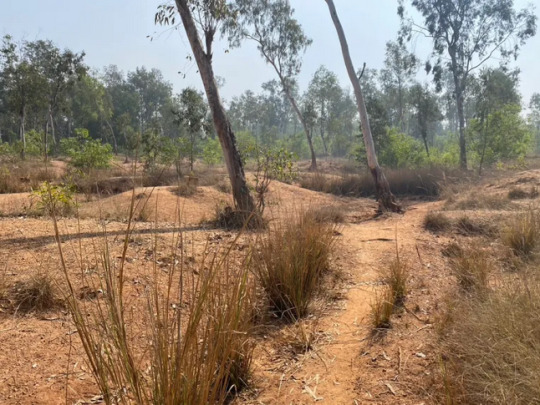
The “khoai” is the name colloquially given to [...] landmasses in and around the Chotanagpur Plateau in eastern India. Rich in iron oxide, these [...] soils are marked by a rugged and often undulating topography, resulting from millennia of erosion from monsoon rains, the many winding rivers that populate the region and action of winds from summer thunderstorms, popularly termed in Bengali as “Kalboishakhi.” The winds and the rains of the kalboishakhi dance across the lands adjoining the Bay of Bengal, often arriving at the horizon with ominous dark clouds right before sunset. [...]
The khoai is a charismatic frontier in an ongoing conversation within South Asian developmentalist imaginaries that call for optimal land use for the purposes of economic growth. [...] As the lateritic soil of the region is not suited for intensive agriculture, efforts have been made to make vast sections of the region arable [...]. And so, slowly, the red soils get taken over the green [...]. This is often done by breaking gullies and hoodoo-like structures [...] to flatten the lands [...]. The ongoing project to turn such “deserts” green has a long history. Yet alongside these projects, is the place that the khoai have in the literary, cultural, and spiritual imagination of many [...] that inhabit the Chotanagpur Plateau. The vastly open and hilly topography, dotted with sal forests [...] has often been the fodder for songs of longing [...]. The horizon of the sky meeting the red gullies of the badlands also form many a narrative that appear in local folk songs and stories. [...] They have also been sites of community-based agroforestry.
---
Recently, such badlands have been termed unproductive in and around my hometown of Santiniketan, India.
As South Asian developmental imaginaries wholly absorb the understanding of terra nullius from modern Euro-American conceptions of land, the idea that “badlands” are necessarily “wastelands” become cemented. Once beloved [...], the dark brown-red hoodoos and gullies today are seen as wasted potential that are depriving the public of much-needed resources, and the possibility of the coming of civilization in accordance with upper-caste aspirations. Khoai today have become sites for proposed plantations facilitated by local forestry authorities, holiday homes and cafes [...], luxury resorts [...].
The ethos of invoking terra nullius has travelled into discourses surrounding “practicality” and the absolute necessity for villagers and small town folks in the area to be saved by their urban-dwelling upper caste counterparts [...] who are interested in their cultural practices, seemingly idyllic agricultural lifeways and the simplicity away from the stresses of cities such as Kolkata. But in this framework, the imaginaries of development are necessarily embedded in compulsory extraction, whether that be of cultural economies, minerals, timber, or land for development. [...]
[B]adlands get turned into places that need saving from being “wasted” by the carelessness and unimaginative shortsightedness of villagers and Adivasis, who are simply seen as ill-equipped to deal with the progression of the global economy.
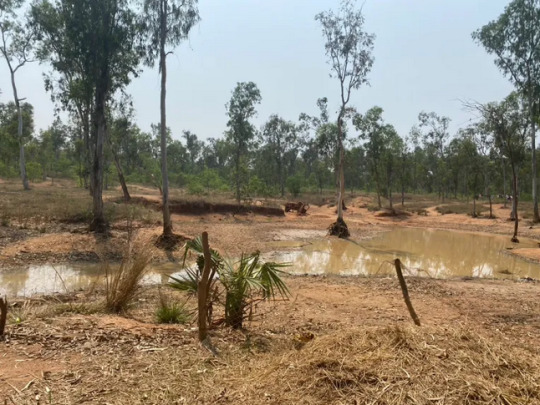
These days, it is hard to find a piece of the “khoai” that has not been subjected to projects of agriculture, forestry, or have been subjugated to [...] property ownership [...]. As the figures of the plantation and its attendant cultures of enclosure and theft of commons creep into places previously overlooked by the tentacles of global extractive forces, many, if not most khoai areas are mobilized to be “redeemed” into productive little plots legible to capital.
I have to wonder about the processes of consent and negotiation that have informed such projects. [...] These areas were in the past predominantly inhabited by Adivasis or Indigenous peoples of India, who had resisted the [...] hierarchies [...].
Badlands such as the “khoai” present a challenge to capitalist imaginaries because they defy its temporalities and its compulsion to make all aspects of being productive and legible to exchanges that foster logics of uninhibited growth. [...]
What, then, does it mean to care for wastelands? [...]
What histories are paved over by concrete? What does development mean in places where inequality is still rife, but there are shiny new roads? What does a future look like, where we can let badlands and “wastelands” just be, as part of ecological and cultural commons?
---
Text by: Aadita Chaudhury. "Caring for Badlands". The Otter, Network in Canadian History and Environment (NiCHE). Emotional Ecologies series. Ed. Jessica M. DeWitt and Sarah E. York-Bertram. 14 July 2023. [Photography by Aadita Chaudhury, included in the original article. Bold emphasis and some paragraph breaks/contractions added by me.]
101 notes
·
View notes
Photo
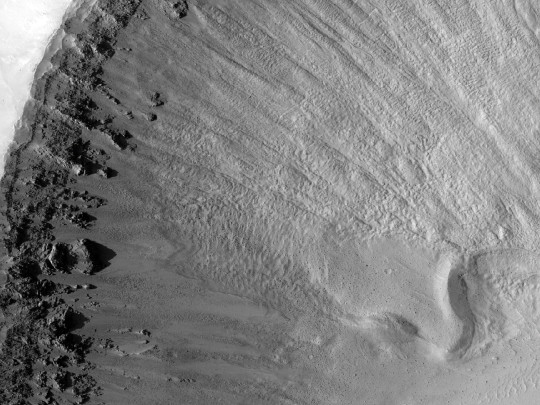
HiPOD 8 Dec 2022: Pristine with Gullies
We call this 7-kilometer diameter crater “pristine” because while it is old, the rim is fairly sharp and not very eroded. The science goal for this observation is to investigate the topography of the east-facing wall, pictured here, where gullies and mantling deposits transition to the normal crater wall.
ID: ESP_066465_1435
date: 30 September 2020
altitude: 252 km
NASA/JPL-Caltech/UArizona
39 notes
·
View notes
Text
Keeping the Water in the Ground with Swales
It’s scorching hot and the rains just won’t come. You can use water from your well to keep your plants from dying, but under these conditions the water table could just drop, leaving you high and dry. Then, when the long awaited rain comes, half your topsoil could get washed away in the downpour. So horrible, yet so familiar! Fortunately, there is a really neat technique that makes sure your water will stay on – or rather under – your land, instead of ripping through the surface before flowing away never to be seen again.

image source
The Behavior of Water
It’s a good idea to take a close look at what water does during a heavy rainstorm. True, most of us don’t enjoy running around under the open sky when it’s raining cats and dogs. But it can be very educational to observe the natural flow of water. It always takes the quickest way down (never up). And depending on the flow, which in turn depends on the amount of water and the ground’s inclination, it can even tear its own way through the landscape. If the ground is fairly dry and without much vegetation, you will even see how a small stream can create a gully – growing into veritable canyons – by carrying sediment with it.

image source
That sediment may be your valuable topsoil! And fairly soon after the rain stops, it will be gone, along with the stream of water. Where did it all go? Just follow the canyon, and you are likely to find it leading away from your land, towards the lower elevations.
But That’s What Water Does. How Can We Counter It?
Admittedly, we will never change the natural behavior of water. What we can do, however, is use it for our purposes. So if it really always goes downhill, let’s give it a place to go: a ditch dug out on the contour line of a hill, which is known as a swale. And that’s all! Since the swale is on contour, meaning that it’s completely horizontal, the water is not going to go anywhere from there until the swale is full (something we must also prepare for). Now that the water lost its momentum, it’s simply going to sit there, and slowly seep downward into the soil. There it won’t have the speed it normally flows with on the surface, so it can’t carry away any soil. Instead it gradually saturates the ground on the hillside below the swale.
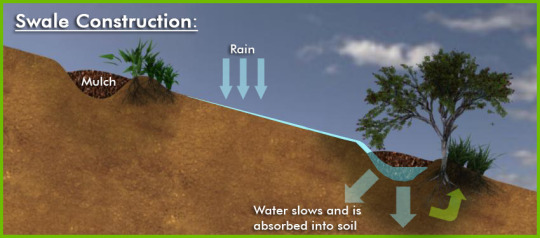
image source
How to Build Swales
It’s really quite simple: First comes the precision work of measuring out the contour line, followed by the grunt work of digging. You may use machines if your topography allows, or do everything by hand, but in either case, exact measurement is the make-or-break aspect of a swale. There are many different methods for this, ranging from the modest (yet effective) A-frame, to the hose level, all the way to the high-tech laser level.

When you are certain that the line is exactly horizontal, you can start digging the trench. Though it can be smaller, I personally like a bigger swale of about 2’ width and depth. That way it can take up more water, and over time it will be gradually filled with soil anyway. What’s most important when digging the swale is to make sure that the bottom remains exactly on contour! The excavated soil we pile up on the side of the ditch that’s sloping downward. This berm is an ideal place to plant trees into to hold the soil together, to help with water saturation and dispersal, as well as to shade the swale to slow down evaporation. In a great design they will also grow something you can eat.
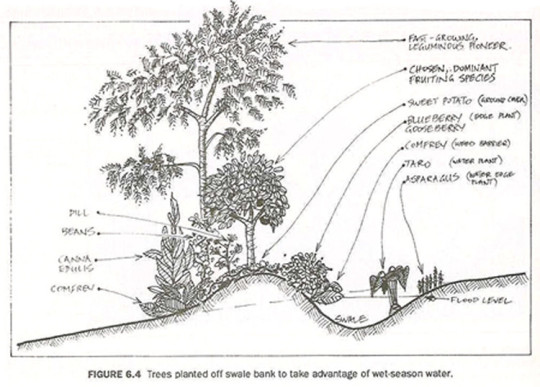
image source
There are a couple of things to look out for: For one thing, the swale should never be placed directly above any buildings (gardens are a much better idea). The best place for them is high up on a hill. Also, make sure the slope doesn’t exceed 15 degrees. Both of these are basic safety measures against slides. It’s also important to make sure the bottom of the swale has a decent water saturation, of at least an inch per hour. Finally, one must prepare for record level rainfall, in other words even the best swale will fill up… and then what? The water needs to go somewhere! So have the overflow channeled into a pond, a dam, or any other feature you have installed for water management.

image source
Okay, so you’ve measured out the contour line, dug a nice big swale, planted trees into the berm, and double-tripple checked that the bottom of your ditch is perfectly level. Great, now you can lean back and wait for the rain! When it comes, get out there again to see how your swale is performing.
Maintenance and Long-Term Effects
After a year or so you can take a look at the swale, preferably when it’s not full of water. You’ll see that it’s not as deep any more as how you dug it. It has filled up with soil: your topsoil! This is your land, that otherwise would have been carried away to your neighbor, or eventually into the ocean, to be lost forever. But here it is, ready to be dug out and used for planting. Of course once again, it’s important to keep the bottom completely leveled.
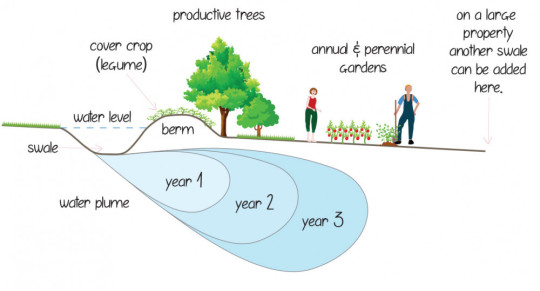
image source
The other effect you are not likely to see immediately, is the water inside, that is under your ground. This is a very gradual process, but the water is going to hang around much longer inside the soil than on the surface. After a while it adds to the water table, and … depending on numerous factors … it will raise it again. There have been many accounts of wells that have been dry for years started having water again, a few years after a swale was built on a nearby hill. But since farming and gardening naturally makes you want to think long-term, this technique will fit right into it.
sources: 1, 2, 3, 4, 5, 6, 7, 8, 9, 10
25 notes
·
View notes
Link

The sculptures found in Grenada’s underwater park have become one with the space in such a profound way that upon diving to see them firsthand, you may be led to believe, based on what you see and the atmosphere, that art has existed since ancient times. Not so, as the park was first constructed in 2006. Constructed from concrete and steel, some of the sculptures weigh as much as 15 tons. They’re held in place by bolts, on the bottom of the seafloor. The sculptures, 75 in all, lure divers of all sorts and even glass bottom boat tours, which also get decent views due to the fact that some of the sculptures are relatively close to the surface.
Thus far, Grenada’s Underwater Sculpture Park has stood the test of time; though you’ll notice that some did not escape completely unscathed. It’s just as well though, as the essence of the sculptures remain, and the national park continues to support conservation efforts as some of the entrance fees are used to aid marine management initiatives.

There are quite a few sculptures just waiting to be explored at the underwater sculpture park. The intention of the British sculptor who created it was not just to put together something that would look good underwater but would also aid conservation efforts. Reef damage had already been done, and the statues were put in after to help protect the reefs, help maintain the health of the ecosystem, and eventually, help restore underwater life in that area.
This is one of the highlights of the Grenada Underwater Sculpture Park. Christ of the Deep was created by Troy Lewis. Its installation was supported with funds from the Grenada Tourism Authority. This sculpture happens to be a replica of the original sculpture sited on the waterfront of the Carenage, St. George's harbour, which was given in gratitude to the people of Grenada for their hospitality and selflessness when they aided 600 passengers and crew members of the Bianca C. At its installation, the underwater sculpture marked the 50th anniversary of the Bianca C sinking. This wreck, the largest in the Caribbean, is also a popular scuba diving site.

Truly iconic, this sculpture features a group of children, 26 in all, Grenadian, and holding hands. They are positioned in a circle, and there are varying interpretations for this work of art. Some say it represents the circle of life, while others say that the children represent slaves thrown off ships so many years ago. There is a trend of thought that suggests it may even relate to the lives of these slaves being cut off, but largely, the true meaning remains a mystery. The creator, Jason deCaires Taylor’s true intent moves in and out with the waves. Still another analogy suggests that the concrete sculpture depicts “the adaptability of children in any environment as the sea embraces them and the children become part of their new environment”. Whatever was the intention of its creator, the Vicissitudes is a truly historic piece, and it is certainly a sight to behold on an underwater dive.
Read more here-:https://www.sandals.com/blog/underwater-sculpture-park-grenada/ and https://grenadaunderwatersculpture.com/grenada/
#sexypink/Grenada Underwater Park#sexypink/Jason deCaires Taylor#sexypink/Grenada Underwater Sculpture Park#sexypink/Grenadian Sculpture#tumblr/Grenadian Art#tumblr/Jason deCaires Taylor#sculpture#underwater sculpture#Grenada#Grenadian Art#sculpture park
4 notes
·
View notes
Text
Discover the Alarming Truth: Erosion May Be Closer Than You Think
Erosion is the gradual wearing away of surface materials like rocks, sediments and soil. This natural process is usually caused by water, wind or glaciers.
Erosion is sometimes stimulated by human activities, such as intensive agriculture, deforestation and construction. Erosion also reduces the ability of soil to hold nutrients and moisture, affecting crop emergence, growth and yield.
Soil Erosion
Soil erosion happens when wind, rain or moving water detaches and removes soil particles. It’s a natural process that can be speeded up by human activity, such as tilling (plowing) fields or clearing forests for agriculture and development.
The top layer of soil is incredibly precious, as it’s packed with nutrients and organic material that’s essential for growing crops. When erosion destroys this valuable layer, it limits the amount of food we can grow and causes many of our most critical ecosystems to decline. This is a problem that has led to the downfall of civilizations in the past, and it’s why preventing erosion is so important for human survival.
Eroded soil doesn’t disappear entirely, but it can wash downstream into rivers, lakes and oceans where it contributes to nutrient overload and diminishes water quality. This impacts the wildlife that calls these water bodies home and humans who rely on them for drinking, farming and other activities.
Soil degradation also means fewer plants can grow, which can impact climate change because trees and other vegetation are natural carbon sinks. The world’s soil is currently eroding 100 times faster than it forms, and improved land management practices could help to slow this rate. For example, leaving a cover crop on annual row-crop fields can reduce erosion by 30%, as well as promote healthy, sustainable crop production.
Water Erosion
While it’s hard to believe, even a single raindrop can have a devastating impact on the environment. As rain, runoff or melting snow erodes rock and soil, loosened particles are carried away by water or wind, forming gullies or transporting sediment across the landscape. This process is called erosion and can impact a variety of habitats from rivers to wetlands.
Erosion can be caused by a variety of factors such as climate, topography, vegetation and tectonic activity. The climate factor is the most important since precipitation and wind can erode weathered sediments. Topography can also influence the likelihood of erosion as earthen floodplains are more prone to erosion than rocky river valleys. Vegetation can help slow erosion by adhering to soil and rock particles, preventing them from being transported during rainfall or wind events. This is especially true for plants that have deep roots, such as trees and shrubs. Erosion can be controlled by practicing sustainable agriculture, proper grading of the land and maintaining soil health through conservation practices such as contour plowing and terracing.
Long-term impacts of erosion can include loss of fertile topsoil, which degrades crop yields and makes farming more difficult. It can also lead to pollution of rivers, streams and lakes from eroded material that washes into these bodies of water. It can also decrease biodiversity and clog waterways, such as the sediment-clogged Jakarta river that caused flooding in early 2019. Climate change, which leads to more frequent and intense storms, can exacerbate erosion as it causes hotter temperatures and longer droughts that make land less able to support healthy vegetation that would otherwise take up climate-warming carbon dioxide.
Construction Erosion
Construction erosion is a huge issue for the environment because it causes sediment to wash away from the areas where construction is happening. The erosion can lead to a lot of problems for the surrounding area, including water pollution, clogged drains and even damage to the building that is being constructed. However, it is possible to control erosion on construction sites with the right preparation and preservation techniques.
The biggest reason that construction erosion is so bad for the environment is because it destroys topsoil, which is the most fertile part of soil. The loss of topsoil leads to the death of plant roots, which makes it impossible for plants to get enough nutrients and leads to a decrease in crop yields.
Additionally, erosion caused by construction can also wash pollutants into nearby rivers and lakes. This can cause a lot of trouble for the local ecosystems, resulting in lower water quality, habitat destruction and interference with fish spawning.
One way that construction erosion can be controlled is by using vegetation to help reduce erosion on the construction site. Plants act as a natural barrier and help slow the flow of rainwater, which in turn helps prevent erosion. Another way is to use construction phasing, which means building only a small part of the site at a time rather than working on all of the land simultaneously. This can help to reduce erosion by limiting the amount of bare dirt that is exposed at once and by allowing for vegetation to grow over the site after it has been finished.
Dam Erosion
Dams can change the flow of rivers, burying riverbanks and putting infrastructure like bridges at risk. The sediment that erodes around dams can be particularly destructive, and may carry toxic chemicals or harmful pathogens to surrounding ecosystems. Those chemicals and pathogens can also affect humans living downstream.
Erosion around dams is often the result of a combination of factors including overgrazing, lack of vegetation, concentrated runoff and the location of the dam in relation to its surroundings. Low areas in a dam crest, poor riprap coverage and gaps in the spillway can all contribute to erosion.
Internal erosion is another dangerous problem that can occur in dams. This happens when the hydraulic forces exerted by seeping water cause the elongation of cracks in the dam’s embankment, foundation and abutments. If the crack continues to erode backwards toward the reservoir, it can cause a catastrophic breaching of the dam. Internal erosion is usually accompanied by episodes of sand boil deposits, but it may not always be visible.
All types of erosion are damaging to a dam’s structural integrity and must be controlled. The best approach to controlling erosion is preventing it before it starts by monitoring a dam regularly for signs of problems. When signs of erosion are detected, the dam owner should lower the reservoir pool to avoid overtopping, notify state and local authorities and seek a professional’s advice.
0 notes
Text
Erosion: What it is, How it Works, Types
What Is Erosion?
Erosion is a natural process through which Earth's surface is worn away by the action of natural forces such as water, wind, ice, and gravity. It involves the removal and transport of soil, rock, and other materials from one location to another. Erosion can occur in various forms and at different scales, ranging from the microscopic movement of particles to the massive shaping of landscapes.
Several factors contribute to erosion, including:
Water: Water erosion occurs due to the impact of raindrops (splash erosion) and the flow of water in streams, rivers, and oceans. Water can wear away soil and rock, transporting sediments downstream.
Wind: Wind erosion happens in arid and semi-arid regions where strong winds can lift and carry loose soil particles, leading to the degradation of soil quality.
Ice: Glacial erosion occurs when moving glaciers pick up rocks and debris, scraping and shaping the underlying surface. This process is essential in forming features like valleys and fjords.
Gravity: Gravity causes mass movements such as landslides, rockfalls, and soil creep, which result in the downslope movement of materials.
Biological Activity: Plants with their roots stabilize soil, preventing erosion. Conversely, burrowing animals and human activities can disturb the soil structure, making it more susceptible to erosion.
Erosion can have both positive and negative impacts. It contributes to the formation of landscapes over geological time, creating valleys, canyons, and other geological features. However, excessive erosion, often accelerated by human activities like deforestation, agriculture, and construction, can lead to soil degradation, loss of fertile land, sedimentation of water bodies, and altered topography. Controlling erosion is essential for preserving soil quality, maintaining agricultural productivity, and protecting natural habitats.
Understanding the Types of Erosion
Certainly, understanding the different types of erosion is crucial for effective land management and conservation efforts. Here are the main types of erosion:
1. Water Erosion:
Splash Erosion: Raindrops dislodge soil particles, causing them to splash and move small distances.
Sheet Erosion: Thin layers of soil are removed uniformly across a large area.
Rill Erosion: Small channels are formed in the soil due to the flow of water.
Gully Erosion: Larger channels or gullies are formed, usually in hilly areas, due to the continuous flow of water.
Streambank Erosion: Erosion along riverbanks or streams due to the force of water.
2. Wind Erosion:
Saltation: Small particles are lifted and bounced along the ground by the wind.
Suspension: Fine particles are carried away by the wind, remaining suspended in the air.
Surface Creep: Larger particles are rolled or dragged along the ground surface.
3. Glacial Erosion:
Plucking: Glaciers pluck rocks and debris from the bedrock as they move.
Abrasion: Rocks and debris carried by glaciers grind against the underlying surface, wearing it away.
4. Gravitational Erosion:
Landslides: The rapid downhill movement of rock and soil due to gravity.
Rockfalls: Rocks detach and fall freely due to the force of gravity.
Soil Creep: Slow, gradual movement of soil downhill.
5. Biological Erosion:
Root Binding: Plant roots stabilize soil, preventing erosion.
Animal Burrowing: Burrowing animals loosen soil, making it susceptible to erosion.
6. Coastal Erosion:
Wave Erosion: Waves hit the coast, wearing away cliffs and shores.
Abrasion: Coastal rocks are worn down by the action of waves, currents, and tidal forces.
Hydraulic Action: The force of water against the coast dislodges and transports materials.
7. Erosion by Human Activities:
Mining Erosion: Removal of vegetation and soil during mining activities accelerates erosion.
Construction Erosion: Land clearing and construction disturb soil, making it prone to erosion.
Agricultural Erosion: Improper agricultural practices such as over-tilling and lack of cover crops lead to soil erosion.
Understanding these erosion types helps in implementing appropriate erosion control measures and sustainable land use practices to mitigate their negative impacts on landscapes and ecosystems.
Profit Erosion
Profit erosion, in a business context, refers to the gradual decline or reduction in a company's profits over time. This can happen due to various factors and is a significant concern for businesses as it affects their financial stability and long-term sustainability. Profit erosion can occur for several reasons:
Increased Costs: If the costs of raw materials, labor, or operational expenses rise, and a company cannot pass these costs onto customers through increased prices, profit margins can be squeezed.
Competition: Intense competition in the market can lead to price wars, where companies lower their prices to attract customers. While this might increase sales volume, it can significantly reduce profit margins.
Technological Changes: Advancements in technology might render existing products or services obsolete, forcing a company to invest in new technologies to stay competitive. These investments can eat into profits.
Market Saturation: In mature markets, where most potential customers already use a product or service, it becomes challenging to expand the customer base. Companies might have to invest heavily in marketing and promotions to gain a competitive edge, which can impact profits.
Regulatory Changes: New regulations or changes in existing laws can force companies to invest in compliance measures, impacting profitability. For instance, environmental regulations might necessitate costly changes in manufacturing processes.
Economic Downturn: During economic recessions or downturns, consumer spending often decreases. This reduced demand can lead to lower sales and, consequently, reduced profits.
Poor Management: Inefficient operations, ineffective cost control, or mismanagement of resources can lead to profit erosion. Poor strategic decisions or lack of adaptation to changing market conditions can also be contributing factors.
To address profit erosion, businesses often need to reevaluate their cost structures, find ways to increase operational efficiency, explore new revenue streams, invest in research and development, and adapt their business strategies to evolving market demands. Regular financial analysis and strategic planning are essential to identify potential areas of profit erosion and implement measures to mitigate its impact.
Asset Erosion
Asset erosion refers to the gradual decrease in the value or effectiveness of a company's assets over time. This can occur due to various factors and is a concern for businesses as it affects their financial health and overall competitiveness. Here are some common causes and examples of asset erosion:
Depreciation: Physical assets such as machinery, equipment, and vehicles naturally depreciate over time. Their value decreases due to wear and tear, aging, or becoming obsolete, leading to a decline in their market value.
Technological Obsolescence: Assets like computers, software, and other technology-related equipment can quickly become outdated due to rapid advancements in technology. This can make these assets less effective and efficient, reducing their value to the organization.
Market Fluctuations: Assets such as stocks, real estate, and other financial investments can lose value due to market fluctuations. Economic downturns, geopolitical events, or changes in market demand can lead to a decrease in the value of these assets.
Inadequate Maintenance: Failure to maintain physical assets properly can accelerate their deterioration. Regular maintenance is essential to prolong the lifespan and value of assets like buildings, vehicles, and manufacturing equipment.
Licensing and Patents: Intellectual property assets like patents and licenses have a limited duration. Once they expire, the company might face increased competition, leading to reduced revenue from these assets.
Regulatory Changes: Changes in regulations or laws can affect the value of assets. For example, environmental regulations might require costly upgrades to a manufacturing facility, impacting the value of the property.
Brand Erosion: Brand value is an intangible asset that can erode over time due to negative publicity, poor customer experiences, or changes in market perception. A weakened brand can lead to decreased customer loyalty and reduced revenue.
To mitigate asset erosion, businesses need to regularly assess the condition of their assets, invest in maintenance and upgrades, stay updated with market trends, and adapt their strategies to protect the value of their assets. Proper financial planning, risk management, and strategic decision-making are essential to preserve and enhance the value of a company's assets over the long term.
Sales Erosion
Sales erosion refers to the gradual decline in a company's sales over time. This decline can occur for various reasons and can significantly impact a business's revenue and profitability. Understanding the causes of sales erosion is essential for businesses to implement strategies to mitigate its effects. Here are some common causes of sales erosion:
Market Saturation: When a market becomes saturated, meaning most potential customers already own a product or use a service, it becomes challenging to acquire new customers. Existing customers might replace old products, but attracting new customers becomes difficult, leading to stagnant or declining sales.
Increased Competition: Intense competition, especially from new or more innovative companies, can lead to a decrease in a company's market share. Competitors offering similar or better products/services at lower prices can lure away customers, causing sales erosion.
Changing Consumer Preferences: Shifts in consumer preferences, lifestyles, or trends can make previously popular products or services less desirable. Companies that fail to adapt to changing consumer demands might experience declining sales.
Technological Advancements: Advances in technology can make existing products obsolete. Customers may prefer newer, technologically advanced products, leading to reduced sales of older offerings.
Economic Downturn: During economic recessions or downturns, consumer spending often decreases. People may cut back on non-essential purchases, leading to lower sales for various industries.
Poor Marketing and Advertising: Ineffective marketing strategies, outdated advertising techniques, or inadequate promotion efforts can result in reduced brand visibility. Without adequate exposure, potential customers might not be aware of the products or services offered, leading to decreased sales.
Customer Dissatisfaction: Poor product quality, unsatisfactory customer service, or negative reviews can lead to customer dissatisfaction. Unhappy customers are likely to switch to competitors, causing a decline in sales.
Global Events: Events such as pandemics, natural disasters, or geopolitical issues can disrupt supply chains, consumer behavior, and overall market conditions, leading to a decline in sales.
To counter sales erosion, businesses can employ various strategies such as introducing new products, improving existing products/services, enhancing customer service, investing in effective marketing campaigns, exploring new markets, and staying up-to-date with consumer trends. Regular market research and customer feedback analysis can also help companies anticipate changing demands and adapt their offerings to prevent sales erosion.
Read more: https://computertricks.net/erosion-what-it-is-how-it-works-types/
0 notes
Text
Knowing when to call yard drainage professionals

Having a beautiful yard is a source of pride for many homeowners, but it can quickly become a headache if you're dealing with water drainage issues. Poor yard drainage in Chagrin Falls can lead to a host of problems, including soil erosion, waterlogged plants, and even structural damage to your home's foundation. While some minor drainage problems can be addressed with DIY solutions, there are times when it's essential to call in the experts. This article will explore when it's time to reach out to yard drainage professionals for help.
Signs you should contact yard drainage professionals
1. Persistent standing water
If you notice areas in your yard where water consistently pools and doesn't drain away, it's a clear sign that you have a drainage problem. These puddles not only make your yard unusable but can also create ideal breeding grounds for mosquitoes and other pests.
2. Soil erosion
Erosion is a silent threat that can undermine the integrity of your landscape. If you see soil washing away during rainstorms or notice exposed roots and the formation of gullies, it's time to consider professional help.
3. Soggy lawn or plant health issues
A consistently wet lawn can harm your grass and other plants. If your lawn remains soggy, and you're seeing signs of stress in your vegetation, like yellowing or wilting, it's a clear indication of poor drainage.
4. Water entering your home
Water should never enter your basement or crawl space. If you notice signs of water intrusion, such as dampness, mold growth, or even visible water, it's crucial to address the issue promptly before it causes significant damage to your home's foundation.
5. Gurgling drains or slow drainage
Inside your home, gurgling sounds or slow drainage in sinks, toilets, or showers could be indicative of blocked or damaged drainage pipes in your yard. This might require professional inspection and repair.
6. DIY solutions haven't worked
If you've attempted DIY drainage fixes, such as adding more soil or installing French drains, and the problems persist or worsen, it's a strong signal that you need professional expertise.
7. New construction or landscaping plans
If you're planning significant changes to your landscape, like adding a patio, or driveway, or expanding your home, consulting with a yard drainage professional during the planning stages can help prevent future drainage issues.
8. Flooding from nearby sources
If your yard is prone to flooding due to factors beyond your control, such as heavy rain runoff from neighboring properties or municipal drainage issues, a professional can assess your situation and suggest appropriate solutions.
9. Water quality concerns
If your yard drainage issues involve contaminated water, like sewage or chemical runoff, it's crucial to bring in professionals to address the environmental and health risks associated with such problems.
10. Preventative maintenance
Even if you haven't encountered severe drainage issues yet, it's wise to consider professional consultation for preventative measures. Experts can evaluate your yard's topography and recommend proactive solutions to avoid future problems.
In conclusion, recognizing when to call yard drainage professionals is essential for the health and aesthetics of your property. Neglecting drainage issues can lead to costly repairs and extensive damage. If you're experiencing any of the signs mentioned above, or if you're planning significant landscaping changes, don't hesitate to seek the expertise of a yard drainage professional. They can assess your specific situation, recommend appropriate solutions, and ultimately help you enjoy a dry, beautiful, and problem-free outdoor space.

TW Landscape
Address : 71 Locust Lane, Chagrin Falls, Ohio, 44022, United States
Phone : (216) 202-2259
Website : https://www.twlandscapeoh.com/
Follow Us On Social Media
TW Landscape On Facebook Page
TW Landscape On Instagram
TW Landscape On YouTube Video
#chagrin falls landscaper#chagrin falls landscaping#chagrin falls ohio lawn care#chagrin falls lawn services#chagrin falls yard drainage
1 note
·
View note
Text
VOLCANOS

VOLCANO
->Vulcan, Roman God of fire
VOLCANO FORMATION
->magma finds a crack or hole in the earth’s crust and bursts through
PARTS OF A VOLCANO

ex:
MAYON
-perfect cone and the most active volcano
-Albay
TAAL
-world’s lowest volcano
-Taal lake in Batangas City
BULUSAN
-Sorsogon
-composite volcano
CANLAON
-Large stratovolcano
-Negros Island
HIBOK-HIBOK
-Camiguin Island
-September 1948 and lasted till 1953
PINATUBO
-chain volcanoes
-Zambales
-most violent and destructive eruptions in the country
Chain volcanoes
-volcanoes positioned in an arc shape
Composite volcano/Stratovolcano
-tall-conical volcano built up by many layers
ex:
MAYON
-perfect cone and the most active volcano
-Albay
TAAL
-world’s lowest volcano
-Taal lake in Batangas City
BULUSAN
-Sorsogon
-composite volcano
CANLAON
-Large stratovolcano
-Negros Island
HIBOK-HIBOK
-Camiguin Island
-September 1948 and lasted till 1953
PINATUBO
-chain volcanoes
-Zambales
-most violent and destructive eruptions in the country
Chain volcanoes
-volcanoes positioned in an arc shape
Composite volcano/Stratovolcano
-tall-conical volcano built up by many layers
POTENTIALLY ACTIVE
->landform is young-looking but w/ no records of eruption
INACTIVE
->no recorded eruptions
->long-period inactivity is evident from too much weathering
& erosion of deep & long gullies (valleys)
EFUSIVE (low silica/less disclosed gasses)
EXPLOSIVE(high silica/more disclosed gasses)

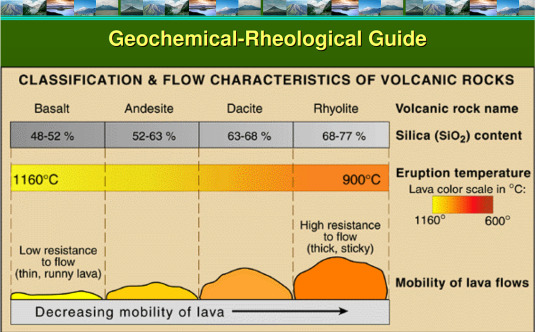
When silica content increases:
temperature decreases
mobility decreases
When silica content decreases:
temperature increases
mobility increases
When temperature decreases:
mobility decreases
silica content increases
When temperature increases:
mobility increases
silica content decreases
When mobility decreases:
silica content increases
temperature decreases
When mobility increases:
silica content decreases
temperature increases

VOLCANIC HAZARDS
GASES
-Basic components of magma or lava (H2O, CO2, CO, H2S, F2, SO2, H2SO4, etc.)
-Mostly toxic species
GROUND FISSURING
-due to movement of magma beneath the surface
-movement / adjustments along faults
-accompanied by earthquakes
DEBRIS AVALANCHE
-horseshoe-shaped crater, hummocky topography
GASES
-Basic components of magma or lava (H2O, CO2, CO, H2S, F2, SO2, H2SO4, etc.)
-Mostly toxic species
GROUND FISSURING
-due to movement of magma beneath the surface
-movement / adjustments along faults
-accompanied by earthquakes
DEBRIS AVALANCHE
-horseshoe-shaped crater, hummocky topography
GASES
-Basic components of magma or lava (H2O, CO2, CO, H2S, F2, SO2, H2SO4, etc.)
-Mostly toxic species
GROUND FISSURING
-due to movement of magma beneath the surface
-movement / adjustments along faults
-accompanied by earthquakes
DEBRIS AVALANCHE
-horseshoe-shaped crater, hummocky topography

0 notes
Text
10 Best Pronghorn Antelope Hunting Tips
Do you hunt pronghorn antelopes? Would you like to take down more antelopes? In this article, we share pronghorn antelope tips to help you take more antelopes home during the hunting season.
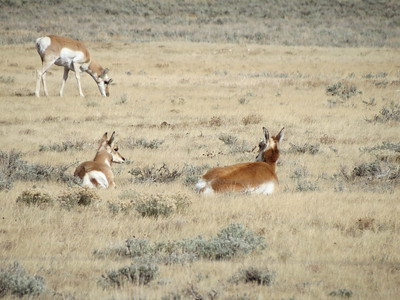
1. Pronghorn Alarm System
When a pronghorn antelope is alarmed, the white hair on its white rump will be raised. This signals to other antelopes that danger is nearby. When you are stalking a herd of pronghorns, you should also be mindful of this. You should watch the white hair on them to see if any is raised. If it is raised on any of them, you should back down. Put some distance between you and them.
2. Pronghorn Defense System
Pronghorns have very good vision and speed. These qualities are part of its defense system against predators. It can see half or three-quarters of a mile away. Additionally, they can run more than 55 miles per hour. So when you are hunting pronghorns, remember their remarkable vision and speed.
3. Field-Judging Pronghorns
When you are hunting pronghorns, you can visually determine if it is a trophy antelope or not. If the horns appear to be longer than 13 inches, chances are it is a trophy antelope. The measurement starts from the base of the pronghorn's ear to the tip of its nose.
4. Old Pronghorn Flagging Trick
Indians used this trick to lure pronghorns and it is also used today by modern hunters. It involves teasing the pronghorns to come nearer, then ease away. Then come nearer and then ease away again. It requires patience and hard work. it is a game of brinkmanship and eventually flags the pronghorn from ambush.

5. Judging Pronghorn's Size
If you are less than half a mile away and you can clearly identify a prominent black spot on the side of its head, chances are it is a big and mature buck that you should go after. If you would like to learn more about the best pronghorn antelope hunting tips, then click the link.
6. Use Laser Rangefinders
Antelope hunters often miss their targets because they don't believe they are as close as they really are and often overshoot the target. To correctly gauge the distance, use a laser rangefinder when hunting pronghorn antelopes.
7. Well-placed Shot
Antelopes are very tough animals. Even after being fatally wounded, they will go for some distance before falling down dead. Therefore, you should always try to hit it in the kill zone to deliver a fatal blow. Even then, it will not just drop dead. Be prepared to follow it for a considerable distance before it eventually falls down dead.
8. No Need For Long Shots
Pronghorn antelopes are often found in flat land that is often intersected by ravines, coulees, ridges, hills, gullies, and divides. Take advantage of this topography and get as close as possible without getting detected. This will be about less than 200 yards and sometimes less than 100 yards.
9. Pronghorns At The Waterhole
When hunting pronghorns over a waterhole, find the corner they like. When you find the corner and set up, wait until they start drinking before you take a shot. Chances are there will be more than 50 animals at the waterhole during the afternoon.

10. Roost Pronghorns
If you find a herd of pronghorns and stalk them until it is dark, it is possible that they will be in the same area at sunrise. Get close without being detected before dawn to take good shots at them.
Conclusion
Hunting pronghorn antelopes is challenging and involves a lot of patience. In this article, we share pronghorn hunting tips to help you be successful in hunting pronghorns. If you would like to learn more about hunting many other animals, then go to thehuntingterrain.com.
0 notes
Text
Clogged gullies, underpass: Panchkula unprepared for rains
Clogged gullies, underpass: Panchkula unprepared for rains
As monsoon approaches, Panchkula seems under prepared on the ground despite the city’s topography which makes it vulnerable to flooding. The Indian Express hit the city roads to assess the real time situation and found road gullies clogged at various places. The cleaning of gullies by the Municipal corporation (MC) has not begun yet which ideally which should have been done before the onset of…

View On WordPress
0 notes
Photo
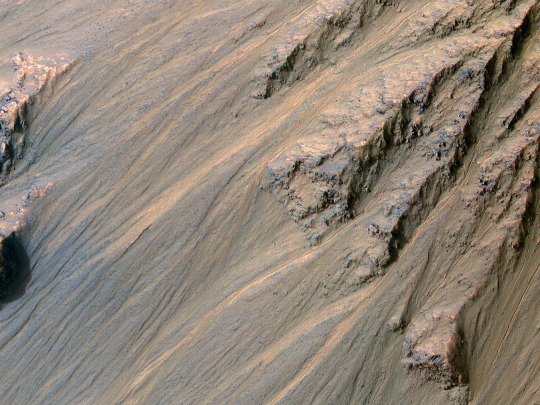
HiPOD 20 Apr 2022: Recent Gullies in Equatorial Valles Marineris
Although actively-forming gullies are common in the middle latitudes of Mars, there are also pristine-looking gullies in equatorial regions.
In this scene, the gullies have very sharp channels and different colors where the gullies have eroded and deposited material. Over time, the topography becomes smoothed over and the color variations disappear, unless there is recent activity.
Changes have not been visible here from before-and-after images, and maybe such differences are apparent compared to older images, but nobody has done a careful comparison. What may be needed to see subtle changes is a new image that matches the lighting conditions of an older one. Equatorial gully activity is probably much less common—perhaps there is major downslope avalanching every few centuries—so we need to be lucky to see changes.
MRO has now been imaging Mars for over 16 years, and the chance of seeing rare activity increases as the time interval widens between repeat images.
Enhanced color image is less than 1 km across.
ID: ESP_072612_1685
date: 22 January 2022
altitude: 263 km
NASA/JPL-Caltech/UArizona
63 notes
·
View notes
Text
Surveying and Project Supervision - The Value of Engineering Surveys

Before undertaking any task, it is essential to be sure that correct surveying is performed. Surveying helps you create a clear plan of action regarding how to proceed with your task, and ensure its success. Engineering surveys deal with every aspect of an engineering design and style like the topography in the area, structure from the building, and so on. Professional engineering studies are typically much considerably more detailed than those performed by civil technical engineers, and serve further purposes as well.
The main purpose involving an engineering review is to find out more about a site possibly before or after the construction is definitely done. It could be used by simply architects, builders plus civil engineers to organize base plans. Design surveys are essential for all those large size construction projects such as railway traces, roads, dams, links and planned home areas. Civil technicians in particular rely heavily on these people to make sure that the plans are perfect.
These surveys can be separated into various classes depending on their particular purpose. Typically, they fall into three main categories: design, arranging and construction. Planning surveys are completed before the construction work starts with a particular site. That they include channel position surveys and investigation surveys which include channel cross part, valley, gully, up and down control and reservoir area surveys. These types of forms of surveying help engineers obtain a complete picture of the circumstance from the site. Following the planning is usually done, design surveys are done to be able to check the feasibility of the task, and make alterations if necessary.
Construction research could be an important portion of surveying in addition to project management and even they can be done both throughout and after typically the completion of typically the work. They function to keep the over the whole construction process in order to make sure that will all relevant specifications are met. That https://plasterers-barrowinfurness.co.uk/ can end up being used for the preservation from the buildings, when the construction is usually done. Some good examples with this type of surveying include unexpected emergency spillway, principal spillway, existing channel in addition to embankment surveys.
Surveying can be done using various strategies. One of the newest in addition to most methods involving conducting engineering surveys online is using a strategy called lidar surveying. This technique uses 3D scanners to be able to provide accurate measurements of both the inside and exterior involving buildings. However, this particular method can only get used after typically the construction is carried out. Professional surveyors make use of theodolites, Dopplers, total stations and GPS devices to ensure that their particular task is accomplished properly.
The region in which surveying is performed would dictate the tools used by typically the surveyors. Differential ranking up utilizes a mounted telescope and a tripod in order to measure lengths plus angles. Trigonometric leveling uses various numerical equations to support with the surveying. Surveying is a new complicated process and is created by some sort of team of professionals including planning technical engineers, field engineers and hydrologists.
From this article you can see, suitable surveying is surely an important part of job management. If an individual need engineering surveys online done, make certain you seek the services of the services associated with an experienced and reputed professional. Bear throughout mind that just surveys done by certified and accredited surveyors are considered good enough.
0 notes
Text
Surveying and Project Management - The Significance of Engineering Surveys

Before undertaking any project, it is significant to ensure that appropriate surveying is carried out. Surveying helps you come up with a clear plan involving action in order to carry on with your task, and ensure their success. Engineering research deal with every factor of an engineering style like the topography in the area, design in the building, etc. Professional engineering surveys online are usually much even more detailed than patients completed by civil technical engineers, and serve additional purposes as nicely.
The main purpose of an engineering review is to learn more about a site either before or right after the construction will be done. It can easily be used by simply architects, builders and civil engineers to prepare base plans. Anatomist surveys are important for all those large level construction projects many of these as railway ranges, roads, dams, connections and planned non commercial areas. Civil engineers in particular depend heavily on them to make sure that the plans are perfect.
These kinds of surveys could be separated into various categories depending on their purpose. Typically, they fall into three primary categories: design, preparation and construction. Arranging surveys are carried out before the construction work starts in a particular site. They will include channel positioning surveys and exploration surveys which consist of channel cross part, valley, gully, vertical control and tank area surveys. These forms of surveying help engineers get a complete picture of the scenario of the site. Following the planning is usually done, design surveys online are done to be able to check the feasibility of the project, and make adjustments if required.
Construction studies could be an important part of surveying plus project management and they can end up being done both in the course of and after typically the completion of typically the work. They function to keep a check over the entire construction process in order to make sure that will all relevant specifications are met. These people can become used for the upkeep of the buildings, as soon as the construction will be done. Some good examples of this type associated with surveying include unexpected emergency spillway, principal spillway, existing channel and even embankment surveys.
Surveying can be completed using various procedures. One of the newest and even most methods regarding conducting engineering research is using a strategy called lidar surveying. This technique uses 3D scanners to provide accurate dimensions of both the insides and exterior of buildings. However, this kind of method can simply get used after typically the construction is carried out. Professional surveyors make use of theodolites, Dopplers, total stations and GPS UNIT devices to make sure that their task is accomplished properly.
Staircases Barrow in which surveying is completed would dictate the various tools used by typically the surveyors. Differential ranking up utilizes a mounted telescope and also a tripod to be able to measure lengths in addition to angles. Trigonometric leveling uses various math equations to aid with the surveying. Surveying is a new complicated process and even is made by a team of professionnals including planning engineers, field engineers and even hydrologists.
Unsurprisingly, proper surveying is surely a necessary part of project management. If a person need engineering research done, make sure that you hire the services involving a tuned and respected professional. Bear within mind that only surveys done by certified and qualified surveyors are thought very good enough.
1 note
·
View note
Text
Surveying and Project Supervision - The Value of Engineering Surveys

Before undertaking any task, it is important to make sure that appropriate surveying is performed. Surveying helps you produce a clear plan involving action in order to continue with your task, and ensure its success. Engineering surveys online deal with every aspect of an engineering style like the topography from the area, layout from the building, etc. Professional engineering surveys online are usually much more detailed than those completed by civil technicians, and serve added purposes as properly.
The primary purpose involving an engineering study is to find out more about a site both before or right after the construction is definitely done. It can easily be used simply by architects, builders and civil engineers to arrange base plans. Design surveys are necessary for all those large scale construction projects many of these as railway outlines, roads, dams, bridges and planned home areas. Civil technical engineers in particular depend heavily on all of them to make certain that the strategies are perfect.
These surveys may be divided into various categories depending on their very own purpose. Typically, they fall under three main categories: design, setting up and construction. Preparation surveys are carried out before the construction work starts at the particular site. That they include channel alignment surveys and exploration surveys which contain channel cross segment, valley, gully, straight control and tank area surveys. These kinds of forms of surveying help engineers acquire a complete photo of the condition in the site. Right after the planning is usually done, design surveys are done to be able to check the feasibility of the task, and make alterations if possible.
Construction surveys are an important component of surveying and even project management and they can become done both throughout and after typically the completion of the work. https://paintersanddecoratorsbarrow.co.uk/ assist to keep the over the entire construction process in order to make sure that will all relevant specifications are met. These people can become used for the preservation in the buildings, when the construction is usually done. Some illustrations of the type involving surveying include crisis spillway, principal spillway, existing channel and embankment surveys.
Surveying can be completed using various approaches. Among the newest and most effective ways regarding conducting engineering surveys is using a technique called lidar surveying. This technique makes use of 3D scanners to be able to provide accurate proportions of both rooms and exterior regarding buildings. However, this method can simply get used after the construction is done. Professional surveyors employ theodolites, Dopplers, entire stations and GPS DEVICE devices to ensure that their very own task is accomplished properly.
The region throughout which surveying is completed would dictate the various tools used by the particular surveyors. Differential leveling works on the mounted telescope along with a tripod in order to measure lengths and angles. Trigonometric leveling uses various statistical equations to support with the surveying. Surveying is the complicated process plus is made by a team of specialists including planning technicians, field engineers in addition to hydrologists.
This is why, appropriate surveying is definitely an important part of task management. If a person need engineering surveys done, ensure that you retain the services of the services regarding a trained and respected professional. Bear inside mind that just surveys done by simply certified and qualified surveyors are thought great enough.
1 note
·
View note
Text

On Duty - Day 1, Trailbreaker Week 2021!
Teebs, Hound and the Twins on patrol in the southwest! 🏜☀️🧡 @teebsweek
#i rly wanna make this into a print or smth#i just love drawing these guys#patch.art#teebsweek2021#trailbreaker#hound#sunstreaker#sideswipe#arizona#gully topography#badland topography#geology#transformers#maccadam#traditional art
43 notes
·
View notes
Text
to be known by you | reiner braun
(reiner braun x reader)
it had been the strangest summer of recent memory: the days were lingering and dilatory, and rife with inexplicable phenomena. when reiner meets a stranger he feels he recognizes, someone as ethereal and bizarre as the summer atmosphere itself, he cannot resist the beguiling nature of this newfound acquaintance and decides to accompany them for a night.
word count: 2.7k
It had been the strangest summer of recent memory. The days were lingering and dilatory and often seemed swathed in some turbid and ethereal atmosphere, augmented by an interminable humidity which each day lasted far past dusk. The sun would hang in the sky for longer than its allotted time, and at duskfall, all terrene happenings stilled and gave way to strange, supernal movements to which no living being bore witness. The beach house tenanted by the Brauns, which sat in the very center of this surreal environment and was not much more than a well-maintained shanty abutting the shore—the transition from sparse greenery to sand occurring directly beneath its raised foundation—was too pervaded by this sense of uncanny. The inside seemed impossibly large for the dimensions of its edifice, and doors within moved on their own, and one could easily lose himself, sitting in one place, for hours at a time, staring at the irregularities in the wood wall panels or the microcosmic topography of the popcorn ceilings or the addled patterns in the stained, grey carpets. Reiner liked to taunt Gabi and tell her the house was haunted, but it was something neither was completely disinclined to believe.
It had been the morning of third day that his mother mentioned the storage shed for the first and last time. Reiner, awake since sunrise on account of his prolonged restlessness, and Gabi, wanting to be with him, sat at the kitchen table, Reiner’s unfocused gaze resting on the view outside the window and Gabi’s on a spoon she mindlessly fingered. His mother’s words had drawn his eyes towards her—her stare, intense, eyes narrowed in questioning:
“Were you doing something in the storage shed last night?”
He shook his head ‘no’ and watched her interrogation move from him to Gabi.
“Gabi?”
“Mm?” Eyes not acknowledging her.
“Were you?”
“Was I what?”
“Doing something in the shed? The storage shed. Last night.”
“No.” Gabi finally looked up, not at her aunt but at Reiner, eyes wide and brows raised. Body turning, she met her aunt’s gaze. “Should I have been?”
“It was open this morning,” his mother finally clarified, turning and reaching for a glass as she spoke. “The door was just cracked, but it was open.”
“Maybe someone didn’t shut it all the way.”
“Maybe.”
Her response hung in the air, suspended by doubt, unconvinced of her son’s suggestion. She glanced out the window, towards the shed in question—its door long since closed and locked after her curious discovery that morning—and it seemed to stare back at her.
“It’s nothing.” Gabi’s remark interrupted her aunt’s staring contest with the building. Her tone was playfully dismissive.
“I think you just want to find something to worry about, Aunt Karina.”
“Maybe.”
There was no more mention of the shed after that day, but Reiner, usually awake before the rest of the house, would, without fail, hear his mother exit the house, creep into the backyard, and shut and lock the shed door each morning in the dim-blue dawn light.
Later that same week Reiner had convinced Gabi to camp in the backyard with him under the guise of fun activity, though he truly intended to observe the shed for the whole night. She had been excited at the prospect of staying awake into the morning and then promptly fell asleep before midnight, and for the rest of the time he simply sat, cross-legged and perspiring, under an ether rife with stars, eyes unwavering from that damn shed.
Apparently having dozed off, though, as he awoke to the sound of the back door and his mother’s soft footfalls and opened his eyes to see her locking the shed. Like every morning, a cyclical action of the damned in hell. He accepted the phenomenon as an unknowable and moved on.
—
Reiner could not remember how long they had been there; time moved differently in this place. He drove to explore and found that the main road stretched on forever, never bending or turning, and the area itself laid among an immutable scenery: an arrant wasteland of vacant beachfront housing, like some vast and spanning afterthought. Could you get lost on a road like this? A pavement belt, flanked by stark shrubbery and shallow gullies full of groundwater. Sometimes, the rare stretch of unsettled coastline with a view of the sea uninhibited by copy-pasted housing. There was something beautiful in the desolate and purgatorial landscape.
The road ended at a bridge, one with caving beams and a skeletal substructure which barely supported its own weight. He never dared explore it, or God forbid drive over it, but he often sat in his car, pulled off to the side of the road, and stared at it. Captivated by the disrepair, what it represented—nothing better elucidated the mortality and impermanence of humanity than infrastructural decay. The view would eventually become too unsettling, as if it watched him as well, and he would reverse the car and turn around and drive back towards the house. When he would arrive, his mother would sometimes report he had been gone for hours, sometimes thirty minutes.
—
“Why don’t you take Gabi to the farmers’ market today?”
He didn’t know there was a farmers’ market, much less even a place to host one. At his mother’s suggestion, though, he drove down that endless stretch of road with Gabi in tow, and miraculously came upon a densely populated park, filled with tents which did little to block the relentless heat. Gabi bounded towards the entrance, Reiner trailing behind, and they quickly ate through the two twenty-dollar bills unceremoniously handed to them before their departure that morning. Reiner was glad his mother hadn’t expected any money to be left.
The park itself held towering trees with sparse canopies which casted amorphous shadows on the dirt paths. So unlike any area found at a coast. Walking along, enveloped in shade and shielded from the sun, one could almost be comfortable. The main walkway was wide, easily fitting five people across, and flanked by densely packed tents. Each with their own smiling vendor. They were nice, maybe a little too nice, and each offered a too-wide smile at Gabi as she made off with their too-good products. He was uneased by the whole affair. In retrospect, he couldn’t remember the last time he actually saw people in the area, and he assumed it was because it was so sparely populated. Yet, with the sheer wall of bodies milling around the park, he felt he had accidently wandered into a city, the market itself some kind of microcosmic metropolis. Strange to have never noticed the park while driving; it was never there until it was, as if it materialized out of nothing.
He glanced around him, suddenly struck by Gabi’s absence. A warning call of her name, and at the lack of response, another, more frantic one. He spun around once, scanning the area, and continued to do so despite remarking how the crowd—a singular, ebbing mass of people—perfectly and wholly obscured her location. But she soon yelled his name and beckoned him over to a booth replete with floral bouquets and emitting an aroma so intense he had to pause before continuing into the miasma.
“Can we get some? For Aunt Karina?”
Her eyes pleaded with the potency of a mendicant’s—nothing but a scoundrel, he thought, who knows I cannot say no. He reached into his wallet and searched for bills and found none. He sheepishly asked the vendor, who was obscured by the perennial heaps before them, if they accepted cards. A soft ‘yes’ spurred Gabi on to grab at a bouquet of yarrow and roses, a perfumed, white and yellow amalgam; a movement which revealed the vendor’s face.
Reiner was struck immobile. You, once hidden, now revealed, were immediately alluring, aura imbued with such profound familiarity. As if you were already his lover. He stumbled through his transaction as you stared at him with eyes he felt he knew.
“Would you like to include a handwritten note?”
Gabi nodded furiously, as if possessed by some excitable demon. She dictated a note, childishly simple yet unequivocally kind, and you wrote it out on a notecard with a flourish. Wrapping the cluster of flowers in tissue paper and tulle and tucking the note in the center, ending the routine by handing it to Gabi. With a smile that was just right. She ran off again, and Reiner waited for a moment longer, as if he knew to wait to be handed that scribbled note which read, ‘Meet me at the bridge tonight.’
You felt so much like a memory. He could not shake the feeling he knew you, deeply and wholly.
—
Such vague wording, as if designed to make one second guess himself. He would have to trust his instinct about the time. In the moment he felt as if he knew you, but your thought process was unfamiliar to him—had you been struck by the same overwhelming feeling of familiarity? Assumed he would understand what ‘tonight’ meant? Or was this some omniscience taunting him and his implicit trust of a stranger?
He was at the bridge by sundown. Car idled. He waited. An hour, a minute. And suddenly you were there—he jumped when he saw you. You sat on the rotted and caving beams of the bridge, beckoning him with a gaze. He approached you and stood at the first interstice between road and bridge and after a pause, dumbly said:
“I think I know you.”
And you confirmed his sentiment with echoed words. He creeped onto the railing, supporting himself on rusted girders resembling steles erected to commemorate some bygone and lost epoch. The chapped wood on which he sat dug into his thighs, and when he looked down, his feet hung over a canyon which in the dark became some measureless void. Your sillage, floral and penetrative and everlasting. You seemed to fluoresce in the pitch.
“Have you ever been in love?”
Your timid venture—the question, just for him. He stared at you and thought for a moment and replied no, not that he could remember. You asked him if you could tell him of your first love, puerile and real. He nodded yes. And you began:
You spoke beautifully and openly about your childhood with a rawness, a candor, otherwise unshared between strangers. You spoke of how your memories were places and people, painted in golden hues. How your childhood room was always bright—in the morning, the rising sun would creep onto the bedroom wall and stay there as if resting in a lover’s embrace; and at sunset, the light would grow weary and slink away to make room for the night. How those walls saw many things: your great-grandfather’s paintings, your mother’s smiling face. And how it all smelled so distinct, even now, like old books and incense. How, as a child, you often felt like some unchanging cairn laid solely to watch the world move around you.
And as you spoke about the young boy you had once loved, Reiner thought of the way this intellection you so tenderly painted sounded like him: a child, tall, with a mess of blonde hair and hazel eyes that held an unusual intensity; a child with a tender voice, high-pitched and soft, and a lopsided smile. And you repeated the words, “I can so clearly remember him,” like some unspoken truism. You had shared your favorite places with this boy; your first kiss, and your hopes and fears; and the pain of aging and coming to know the dark and black and crushing void associated with it.
You spoke of how the young boy suddenly died, without explanation. How the last time you saw him, there was such a pervasive sadness in his gaze. How you despised this was the way you remembered him—with mournful and darkened eyes. You had asked what was wrong, and he had not been sure. Instead, the two of you clasped hands and sat in silence for a last time.
“I just remember the chaos.” A whisper, spoken more to yourself.
“I remember waking up to blue lights on my ceiling. It was a cold blue light, a crude perversion of the warmness of the rising sun. I looked out the window, and cars were crowded under the flickering streetlamp below, and I heard the wailing through my window. I knew. I knew, but I just climbed in my bed and pulled the covers over my head, as if they would drown out the light and the shouts of a broken mother, and squeezed my eyes shut and saw his eyes and cowlicked hair and a toothy, lopsided grin.”
You asserted that part of you died with him. A pause.
“It felt odd to be in love with someone who was already dead.”
And then you were finished. You took a deep breath, as if the story had been spoken with one, single inhalation. Reiner blinked hard and processed the words and tried to think of something to say. ‘Sorry’ seemed so blithe.
“What was his name?”
You shrugged your shoulders.
“I can’t remember.”
He stared at you, incredulous, half-expecting you to be joking. How could one possibly—
“Sometimes I think he didn’t have one.”
Your whispered voice, as if about to shatter: “You remind me of him. That’s why you’re here.”
Effervescent words that dissolved in the air. Something nagging at the back of his mind. He wrapped you in an embrace and held you there, and he thought not of you as a stranger. A hand on your back and the other in your hair. Breathing your exhalations. An intimacy impossible between two unfamiliar people. He swore he knew you.
He felt your lips on his neck, testing, inquisitive. He pulled back, meeting your gaze, eyes melancholic and wistful and searching for something intangible, possibly nonexistent. You had the eyes of someone who was never anything but lost, and despite your shared unfamiliarity, he hoped you would find something within him as he leaned to press his lips to yours. This kiss begot another and another, and his hand was on your cheek, and your skin was warm beneath his fingers, betraying your spectral nature. He thought he heard you whisper his name, though it was something you couldn’t have known.
He held you, again, with no desire to do more; this chaste intimacy was so much more potent. He savored your embrace and felt he could stay here, in your presence, with your touch, until he aged and crumbled like the disintegrating bridge on which they sat. A moment of abject redamancy. Time moved differently here, with you.
He was then inexplicably struck with the feeling that he missed you, as if he had finally found that which he had gone years without.
You pulled away and stood. Without warning.
“Can I see you again?” His plea, desperate, closing.
“I’m not certain.”
And with that, you asked him to leave. He somehow knew he was meant to comply without question.
As he departed, and behind him the road and the bridge and you faded into blackness, he was reminded of the first time he moved homes—that unsettling and melancholic feeling of abandoning something familiar. He drove and drove and missed his street, and instead of turning around, he surrendered to the compulsion to keep driving, and he drove some more. He thought of you the entire time, oblivious his own existence. He then thought of himself, and when reflecting on his childhood, he could not remember it; he only saw himself in the presence of a young child who looked like you, a shared heart between you. He drove through the sunrise and another sunset, and he stopped to fill up his car with gas and kept driving. He wasn’t sure how, but he eventually found his way back to the beach.
He arrived at the house and quietly climbed into bed. He imagined you dissolving into the landscape; the canyon beneath the bridge widening like an open mouth and swallowing you. Purloined by the purgatory which begot you.
He suddenly could not remember your face.
A thought, lost, just as he heard his mother closing and locking the shed door outside.
—
thank you again to @casualityrantfun for suggesting a reiner piece! it was very sweet of you to request something, and i hope you enjoy it. also, thank you to everyone who has been reading/liking/reblogging my stuff! it means the world to me, and i really love being able to write creatively for something i enjoy!
part of me wants to make this a long-form piece, but i don’t think i have the patience or the talent to do so. maybe later down the line, though, we’ll see. also, this piece is inspired by @dappermouth’s art, specifically this piece, which has literally captivated me for years, as well as the campfire scene from my own private idaho, which i watched the day before yesterday and fell in love with. go hold someone you love, xoxo
masterlist
taglist: @flam3bird
#attack on titan#shingeki no kyojin#aot#snk#attack on titan x reader#attack on titan imagine#aot imagines#aot x reader#reiner braun#reiner braun x reader#reiner braun x you#reiner braun imagine#reiner x reader#writing!
99 notes
·
View notes